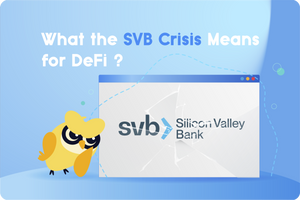Recent news developments have seen the collapse of California-based commercial bank, Silicon Valley Bank (SVB).
👀 In this article, we’ll take a closer look at the flaws that led to the SVB crisis and how decentralized finance, or DeFi, not only differentiates from the current centralized banking system, but can offer the solution to prevent these kinds of financial failures.
🏦 SILICON VALLEY BANK
On March 10, 2023, Silicon Valley Bank (SVB) – a commercial lending facility popular with venture capitalist-backed tech startups based in “Silicon Valley” / Santa Clara, California failed after a run on its deposits.
SVB, along with its parent company, SVB Financial Group, were placed in receivership and its holdings are now being managed by the Federal Deposit Insurance Corporation (FDIC). U.S. Federal regulators have assured that all depositors at SVB would be fully protected and have access to all of their money – including both insured and uninsured deposits (which are greater than USD$250,000 in value).
Starting at its inception in 1983 through to its height of success, SVB was the 16th-largest bank in the United States, and the largest bank by deposits in Silicon Valley. The bank’s customers were primarily business startups in industries such as tech, life sciences, healthcare, private equity, venture capital and premium wine industries.
❓ WHAT HAPPENED TO SVB?
Essentially, in 2022 SVB had around 90% of its accounts with more than USD$250,000 in deposits. This meant a majority of the bank's deposits were not insured by the FDIC. Further, the low interest rate climate prevalent in the global economies since the global financial crisis in 2008 has seen significantly low interest rates over a long period of time. During the pandemic in 2020, these deposits sky-rocketed.
This ended up being a problematic issue as the extra billions were invested in Treasury bonds with long-term maturities. The circumstances that led to SVB’s collapse were triggered by a series of central bank-endorsed interest rate rises amid a global inflation surge. This severely affected the value of government bonds in SVB’s possession. As the tech sector experienced a recent slump and downturn, investors began withdrawing their funds.
This was compounded by earlier collapses of Silvergate Capital, Signature and cryptocurrency exchange FTX in 2022, resulting in an already jittery market. By early March 2023, SVB was forced to sell part of its bond holdings at a loss of USD$1.8 billion.
💱 THE CHANGE FROM CEFI TO DEFI
Many believe the problems which led to SVB’s collapse were caused by problems inherent in the opaque system of centralized finance, or CeFi.
In a financial system controlled by centralized institutions🏛️, an individual user or business’s 💵funds are held by banking companies. These companies have to be trusted not to mismanage its deposited funds.
As we covered in our explainer article on DeFi, in contrast to CeFi, decentralized finance is a collective term for emerging, peer-to-peer financial technology based on secure distributed ledgers similar to those used by cryptocurrencies.
Using the same blockchain technology that cryptocurrencies use, DeFi’s decentralized apps and smart contracts📄 have been designed to take the place of CeFi. These decentralized apps, or dApps, operate in the same way blockchain transactions are recorded. They are basically codes of instruction that run when certain conditions have been met. These are built on layered platforms such as Ethereum.
As we saw in the case of SVB, another flaw in CeFi is where a bank’s clients have limited knowledge of how the bank is conducting its business, and have little to no say in how the business is being managed. These centralized financial institutions and banks are closed books – you can't ask to see🕵️ their loan history or a record of their managed assets.
DeFi, in contrast to this, is built on transparency👀 – anyone can look at a product's trustless data and inspect how the system works.
While regulation can help to protect depositors to some extent (in the U.S., all funds below USD$250,000 are insured by the FDIC), for the most part those funds are under the control of bankers.
These are just some of the many issues facing the current traditional CeFi structure and system, as evidenced by SVB’s collapse.
More and more investors and businesses are discovering the advantages of the DeFi system. What is attracting them? Solutions where users are in direct control of their assets and funds. DeFi addresses the issues inherent with the imperfections of CeFi, and would have directly prevented the disruption of SVB’s collapse.
For further evidence of this, in the week following the turmoil at SVB, the price of Bitcoin pumped up to higher levels. This indicates that in times of current financial turmoil, more and more people are moving their funds and investments from traditional markets to crypto.
🔮 DEFI: LOOKING AHEAD
SVB’s crash poses some serious challenges ahead for both kinds of finance – .CeFi and DeFi. These financial collapses raise the levels of fear, insecurity and doubt in investors’ minds.
Taking this into account, it appears that regulated DeFi is a system that clearly offers the solutions needed to avoid and prevent them from recurring again in the future.
The information provided on this website does not constitute investment advice, financial advice, trading advice, or any other sort of advice and you should not treat any of the website's content as such. Bloom does not recommend that any cryptocurrency or NFTs should be bought, sold, or held by you. Do conduct your own due diligence and consult your financial advisor before making any investment decisions.
